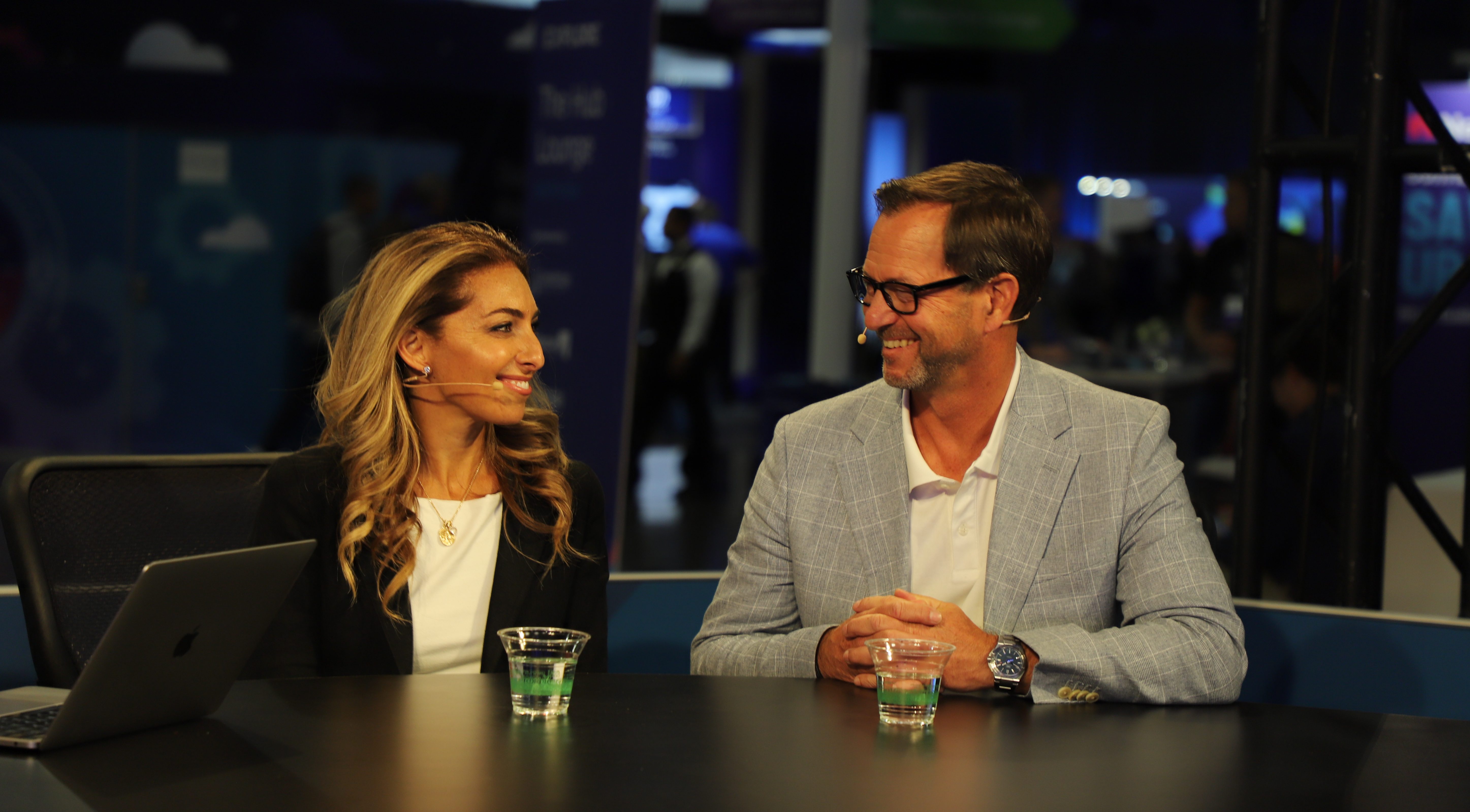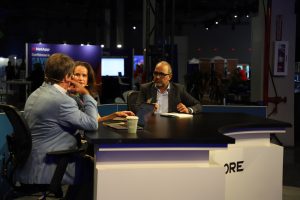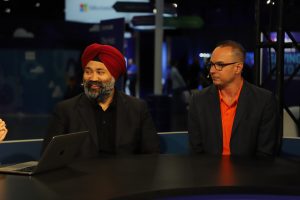 AI
AI
 AI
AI
 AI
AI
Private cloud is reclaiming its seat at the enterprise table, not as a compromise to public cloud, but as the engine of artificial intelligence scalability, workload governance and cost clarity. As AI becomes more deeply embedded across sectors, IT leaders are reevaluating their cloud strategies with renewed urgency.

TheCUBE Research’s John Furrier, Rebecca Knight and Stackpane’s Sarbjeet Johal talk about the VMware Explore keynote analysis.
What’s emerging is a back-to-basics push: Reduce complexity, regain control and prepare infrastructure to meet AI’s steep demands — conditions ideally suited to the private cloud model — without sacrificing cost visibility or compliance. That shift was visible at VMware Explore, where product consolidation and platform unification signaled a clear focus on enterprise-scale AI. Rather than extending across fragmented services, VMware anchored its private cloud AI strategy around VMware Cloud Foundation 9.0. The streamlined approach is designed to support both developer agility and enterprise governance, according to Sarbjeet Johal, founder and chief executive officer of Stackpane.
“I think my first impression is that there’s a lot of cleanup being done this year,” he said. “Long story short, Tanzu was [the] talk of the town a couple of years back, and last year, well, Tanzu’s gone … they’re putting that under VCF 9.0. There’s a lot of … streamlining. The message was more crisp on the AI side this time.”
Johal joined John Furrier and Rebecca Knight to discuss VMware’s product consolidation, ecosystem strategy and AI momentum. TheCUBE’s exclusive coverage featured deep executive insights, enterprise AI strategies, developer-first cloud architecture and use cases powered by VMware Cloud Foundation 9.0. (* Disclosure below.)
Here’s the complete video interview with John Furrier, Rebecca Knight and Sarbjeet Johal:
Here are three key insights you may have missed from theCUBE’s coverage of VMware Explore:
As AI reshapes enterprise strategy, IT leaders face pressure to reevaluate traditional business models and infrastructure placement. For Future Tech Enterprise Inc., the challenge isn’t just cost — it’s the strategic alignment of AI investments with operational flexibility and governance. From categorizing workloads to preparing for chargeback models, the company helps clients navigate the shift toward large-scale AI adoption without falling back into transactional IT habits, according to Michael Watkinson, chief revenue officer of Future Tech.

VMware’s Dilpreet Bindra and Canonical’s Mark Lewis talk with theCUBE about how their organizations are helping companies accelerate innovation without sacrificing security or control.
“Shadow AI is happening everywhere, and how do we bring that to the surface?” he told theCUBE during the event. “When we do that, we start to see patterns. We start to see what’s common, repeatable and scalable. And in doing that, we can start to create everything in a box and the right tools to do the jobs.”
At the infrastructure level, AI’s hunger for bandwidth and low latency is forcing innovation across the data center fabric. Broadcom Inc. has responded by introducing a new generation of networking devices — Tomahawk 6, Tomahawk Ultra and Jericho 4 — built for AI-scale connectivity and congestion control. These products address the growing need to transfer massive data sets between distributed compute clusters while minimizing packet loss and buffering delays, according to Ram Velaga, senior vice president and general manager at Broadcom.
“You need to be able to buffer traffic across these 100-kilometer distances,” he said during the event. “If you have any congestion or if you have any packet drops across these 100-kilometer-separated data centers, you’re able to retransmit from the switches and not have to go back all the way into your host into the [graphics processing unit], pull the data down again and retransmit.”
That pressure extends to application delivery as well, where enterprises wrestle with balancing developer speed and enterprise governance. VMware and Canonical Ltd. are working to dissolve that friction by embedding compliance and controls into the container layer itself, according to Mark Lewis, vice president of global ISV partnerships at Canonical and Dilpreet Bindra, senior director of engineering at VMware by Broadcom. By introducing production-ready “chiseled containers,” the companies enable developers to move quickly while giving IT the tools to enforce governance at scale.
“The chiseled containers are designed for production; they’re secure by design,” Lewis said during the event. “For me, the lazy developer, it takes a whole lot of steps out. I want to be writing code. I don’t really want to be wrestling with containers to make them secure, to then pass some audit, et cetera.”
Here’s the complete video interview with Ram Velaga:
The University of Bristol’s transformation highlights how private cloud can enable agility and control at scale. By implementing VMware Cloud Foundation 9.0, the university unified its fragmented infrastructure into a centralized, secure environment that supports both traditional operations and cutting-edge research, according to Keith Woolley, chief digital information officer of the University of Bristol. This hybrid flexibility empowers researchers to self-provision compute resources while giving IT visibility and cost control.

USSFCU’s Mark Fournier talks with theCUBE about leveraging VMware LLC technology is helping the company empower staff and embrace AI.
“The academics actually bought the equipment themselves,” Woolley said during the event. “Now, they can spin it up themselves as though it’s cloud. We can cost-control it because we know where it is. I can secure it because it’s inside our environment, and they can administrate it. I also get all the availability of being able to build this as well with Kubernetes. I can scale out my coding environments and build what I need within containerization. It’s a win-win situation for everybody.”
Financial institutions are also tapping into private cloud to modernize without disruption. The United States Senate Federal Credit Union is using VMware Cloud Foundation 9.0 and generative AI to upgrade the customer journey and back-end systems without fully retiring legacy mainframes, according to Mark Fournier, chief information officer of USSFCU. By wrapping a modern interface around existing infrastructure, the credit union advances digital transformation while maintaining operational stability.
“Our core banking stack is in line with a lot of other financial institutions,” he told theCUBE. “A lot of what our team works on is what we can build as an envelope around that. We are not going to get that out of the way today or tomorrow, but we can create a more seamless experience at the front end and do a good job for the internal users who are supporting customers, as well as the customers directly.”
In manufacturing, New Belgium Brewing Company Inc. demonstrates how private cloud AI can transform telemetry and operational data into actionable insights. With VMware Cloud Foundation 9.0 deployed at the edge, the company uses AI to monitor and optimize processes such as fermentation and supply chain performance, according to Adam Little, director of IT operations at New Belgium Brewing, and Krish Prasad, senior vice president and general manager of Broadcom’s VMware Cloud Foundation Division. The result is faster decisions without compromising control — another example of how private cloud deployments are delivering real-world value across industries.
“You can consolidate into one big data center or you can consolidate at the edge,” Little said during the event. “In manufacturing, we tend to lean toward edge and distributed, but it is interesting to hear customers, big banks, that say, ‘Hey, I had 40 data centers, and I now have seven,’ that’s enabled them to bring that footprint down.”
Here’s the complete video interview with Adam Little and Krish Prasad:
To bring AI from pilot to production, infrastructure alone isn’t enough — enterprise success increasingly depends on strategic partnerships. That’s the premise behind Advanced Micro Devices Inc. and Broadcom’s joint push to virtualize GPUs at scale, enabling multi-tenant model deployment and enterprise-grade AI performance, according to Kumaran Siva, corporate vice president of strategic business development at AMD and Paul Turner, vice president of products, VMware Cloud Foundation Division, at Broadcom. Their stack combines advanced inference support with seamless orchestration on VMware Cloud Foundation.

11:11’s Dante Orsini and Broadcom’s Ahmar Mohammad talk with theCUBE about how the evolution of VMware Cloud Foundation is creating new opportunities for partners and customers.
“Private cloud is going to be a real thing, absolutely,” Siva said during the event. “Regulated industries need to keep data secure. This is going to be a challenge that … the partnership here really goes a long way to addressing.”
For Broadcom, that partnership mindset extends far beyond GPU hardware. The company’s VMware acquisition prompted a broad simplification effort — streamlining go-to-market motions, aligning platform innovation and focusing the partner ecosystem around full-stack solution delivery. Rather than treating cloud services as add-ons, Broadcom is prioritizing partners that deliver integrated infrastructure, compliance and operational outcomes, according to Ahmar Mohammad, vice president of partners and managed services and solutions at Broadcom, and Dante Orsini, chief revenue officer of 11:11 Systems Inc.
“We are now further simplifying or further rationalizing our [cloud service provider] ecosystem as well and consolidating it down to a selected group of fully committed customer-aligned partners who do this for a living,” Mohammad told theCUBE. “This is not a side show for them. This is not 5% … or 10% of their business. This is the cake. We want to make sure that we can work with them closely, provide the enablement and coverage and then they can go out and serve our customers fully.”
That shift is visible not just in Broadcom’s updated partner incentives, but in how partners are restructuring to meet rising enterprise demands. Organizations no longer need partners who simply sell licenses: They need teams that can drive adoption, manage consumption and deliver specialized services, according to Tara Fine (pictured, left), Americas channel chief of Broadcom, and Pierre Cayouette (right), VMware practice lead at Pellera Technologies. Formed through a recent merger, Pellera built a dedicated VMware SWAT team to adapt quickly to Broadcom’s accelerated pace of change and help customers navigate industry turbulence.
“The role of the SWAT team was basically to very quickly … go in the field … with Broadcom, understanding the pace of the changes,” Cayouette said during the event. “It’s been a wild ride, but you’re talking about doubling down. That was our way of doubling down … [to] give it that focus. It’s like, ‘Okay, things are going to change really fast. We need to structure ourselves differently as a partner to be able to absorb the bumps and to make it through that period.’”
Here’s the complete video interview with Paul Turner and Kumaran Siva:
To watch more of theCUBE’s coverage of the VMware Explore event, here’s our complete event video playlist:
(* Disclosure: TheCUBE is a paid media partner for VMware Explore. The sponsors of theCUBE’s event coverage do not have editorial control over content on theCUBE or SiliconANGLE.)
Support our mission to keep content open and free by engaging with theCUBE community. Join theCUBE’s Alumni Trust Network, where technology leaders connect, share intelligence and create opportunities.
Founded by tech visionaries John Furrier and Dave Vellante, SiliconANGLE Media has built a dynamic ecosystem of industry-leading digital media brands that reach 15+ million elite tech professionals. Our new proprietary theCUBE AI Video Cloud is breaking ground in audience interaction, leveraging theCUBEai.com neural network to help technology companies make data-driven decisions and stay at the forefront of industry conversations.